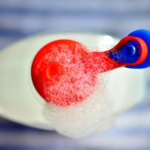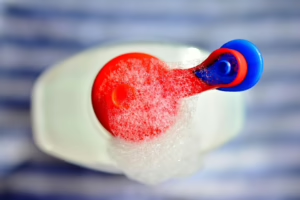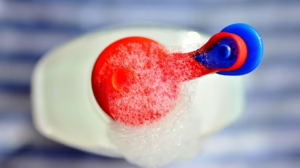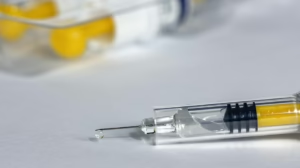Beyond the Beaker: How Chemistry Impacts Your Daily Life
Introduction
Chemistry, often confined to the sterile environment of laboratories and complex equations on whiteboards, is far more than just a subject to be studied in school. It is the fundamental science that underpins the very fabric of our existence, silently orchestrating the processes that allow us to breathe, move, think, and interact with the world around us. From the moment we wake up in the morning to the time we drift off to sleep, chemistry plays an indispensable role in shaping our daily lives, influencing our health, comfort, and even our perceptions of the world. This article aims to delve beyond the image of chemistry as a collection of arcane formulas and hazardous chemicals, exploring the vast and often unnoticed ways in which it touches every facet of our routine, revealing the profound impact of chemistry on our daily experiences.
1. The Morning Routine: A Chemical Symphony
Our day begins with a series of actions, each fueled by chemical reactions and innovations. Consider the simple act of brushing your teeth.
-
Toothpaste [mfn 1]: The familiar minty flavor and cleaning action are products of careful chemical formulations. Abrasives like hydrated silica (SiO2·nH2O) gently remove plaque and surface stains. Fluoride, usually in the form of sodium fluoride (NaF) or stannous fluoride (SnF2), strengthens tooth enamel by converting hydroxyapatite (Ca5(PO4)3OH) into fluorapatite (Ca5(PO4)3F), which is more resistant to acid attacks from bacteria. The foaming action comes from surfactants like sodium lauryl sulfate (SLS), which emulsify fats and oils, allowing them to be rinsed away. Antimicrobial agents such as triclosan (though increasingly phased out due to environmental concerns) or zinc citrate inhibit the growth of bacteria that cause plaque and gingivitis. The sweetness and flavor are often achieved with artificial sweeteners and flavoring agents, all carefully chosen and synthesized to create a product that is both effective and palatable.
-
Soap and Shampoo [mfn 2]: The cleansing agents in soaps and shampoos are primarily surfactants. Surfactants, short for “surface active agents,” are molecules with both a hydrophilic (water-loving) and a hydrophobic (water-repelling) end. This dual nature allows them to interact with both water and oily dirt, effectively emulsifying the dirt and lifting it away from the skin or hair. Traditional soaps are salts of fatty acids, typically produced by saponification, a process involving the reaction of fats or oils with a strong base like sodium hydroxide (NaOH) or potassium hydroxide (KOH). Modern shampoos often use synthetic detergents like sodium laureth sulfate (SLES) or ammonium lauryl sulfate (ALS), which are less prone to forming scum in hard water. Conditioners contain cationic surfactants, which are positively charged and bind to the negatively charged hair surface, neutralizing static electricity and smoothing the cuticle. The fragrances, preservatives, and colorants in these products are also carefully selected and synthesized chemicals that contribute to the overall user experience.
-
Coffee/Tea [mfn 3]: For many, the day doesn’t truly begin until that first cup of coffee or tea. The stimulating effect of these beverages is primarily due to caffeine, a naturally occurring alkaloid with the chemical formula C8H10N4O2. Caffeine acts as a stimulant by blocking adenosine receptors in the brain, preventing the inhibitory neurotransmitter adenosine from binding and reducing neuronal activity. The brewing process involves extracting caffeine, tannins, and other flavor compounds from the coffee beans or tea leaves using hot water. The complex flavors and aromas of coffee and tea are a result of hundreds of different chemical compounds, including volatile organic compounds (VOCs) produced during roasting or fermentation. Adding milk to coffee involves a further layer of chemistry, as the proteins in milk interact with the tannins in coffee, altering its taste and texture.
-
Breakfast [mfn 4]: Whether it’s a bowl of cereal, toast, or a more elaborate meal, breakfast is a complex chemical cocktail. The carbohydrates in cereal and bread are broken down into glucose, providing energy for the body. The digestion process itself is a series of enzymatic reactions, with enzymes like amylase breaking down starch into simpler sugars. The proteins in milk, eggs, or yogurt are broken down into amino acids, the building blocks for repairing and building tissues. The vitamins and minerals in our food are essential for various biochemical processes, acting as cofactors for enzymes and contributing to overall health. Even the cooking process involves chemical reactions, such as the Maillard reaction, which gives browned foods their characteristic flavors and aromas.
2. Clothing and Textiles: Chemistry Woven into Fabric
The clothes we wear are a testament to chemical innovation, impacting comfort, durability, and aesthetics.
-
Natural Fibers [mfn 5]: Cotton, linen, silk, and wool are all natural polymers composed of repeating units. Cotton is primarily cellulose, a polysaccharide composed of glucose units. Linen is also cellulose, but with a different structure that contributes to its strength and durability. Silk is a protein fiber composed of amino acids, giving it its characteristic sheen and smooth texture. Wool is also a protein fiber, but with a more complex structure that provides insulation and resilience. The properties of these fibers are determined by their chemical composition and structure, which in turn influence how they interact with dyes, detergents, and the environment.
-
Synthetic Fibers [mfn 6]: Nylon, polyester, acrylic, and spandex are all synthetic polymers created through chemical processes. Nylon, the first completely synthetic fiber, is a polyamide formed by the reaction of a diamine and a dicarboxylic acid. Polyester, commonly known as polyethylene terephthalate (PET), is formed by the reaction of a diol and a dicarboxylic acid. Acrylic fibers are polymers of acrylonitrile. Spandex, or elastane, is a polyurethane fiber that provides exceptional elasticity. Synthetic fibers offer advantages over natural fibers in terms of durability, wrinkle resistance, and cost-effectiveness. They also allow for the creation of fabrics with specific properties, such as water resistance or UV protection.
-
Dyes and Finishes [mfn 7]: The vibrant colors and special properties of our clothing are achieved through the use of dyes and finishes. Dyes are chemicals that bind to fibers, imparting color. Different types of dyes are used for different fibers, depending on their chemical structure and affinity for the dye. Finishes are chemicals applied to fabrics to improve their properties, such as wrinkle resistance (e.g., formaldehyde-based resins), water repellency (e.g., fluoropolymers), or flame retardancy (e.g., organophosphates). The development of new dyes and finishes continues to be an active area of research, driven by the desire for more sustainable and environmentally friendly options.
3. Transportation: Chemistry on the Move
The vehicles we use to get around, from cars and buses to trains and airplanes, rely heavily on chemistry.
-
Fuel [mfn 8]: The primary source of energy for most vehicles is still fossil fuels, such as gasoline and diesel. Gasoline is a complex mixture of hydrocarbons, primarily alkanes, alkenes, and aromatic hydrocarbons. Diesel fuel is also a mixture of hydrocarbons, but with a higher molecular weight than gasoline. The combustion of these fuels in an internal combustion engine produces energy, along with exhaust gases that contribute to air pollution. Alternative fuels, such as biofuels (e.g., ethanol, biodiesel) and hydrogen, are being developed as more sustainable options. The chemistry of combustion is a complex process involving free radicals and chain reactions.
-
Batteries [mfn 9]: Electric vehicles (EVs) are rapidly gaining popularity, powered by rechargeable batteries. Lithium-ion batteries are the most common type of battery used in EVs, offering high energy density and long cycle life. These batteries consist of a cathode, an anode, an electrolyte, and a separator. The cathode is typically made of a lithium metal oxide, such as lithium cobalt oxide (LiCoO2) or lithium iron phosphate (LiFePO4). The anode is typically made of graphite. The electrolyte allows lithium ions to flow between the cathode and anode during charging and discharging. The separator prevents the cathode and anode from coming into direct contact, preventing short circuits. The chemistry of battery operation involves redox reactions, with lithium ions being oxidized at the anode and reduced at the cathode.
-
Materials [mfn 10]: Vehicles are constructed from a variety of materials, including steel, aluminum, polymers, and composites. Steel provides strength and durability, while aluminum is lighter and more corrosion resistant. Polymers are used for interior components and exterior trim. Composites, such as carbon fiber reinforced polymers (CFRPs), offer high strength and low weight, making them ideal for aerospace applications. The development of new materials with improved properties is crucial for improving fuel efficiency and reducing emissions. Corrosion prevention is also a critical area of research, as corrosion can weaken vehicle structures and compromise safety.
4. Home and Environment: Chemistry in the Four Walls
Our homes and the environment around us are filled with chemical processes and products that influence our comfort and well-being.
-
Cleaning Products [mfn 11]: From dish soap and laundry detergent to disinfectants and window cleaners, cleaning products rely on chemical principles to remove dirt, grime, and pathogens. Detergents contain surfactants that emulsify fats and oils, allowing them to be rinsed away. Bleaches contain oxidizing agents, such as sodium hypochlorite (NaClO), that break down colored stains. Disinfectants contain antimicrobial agents, such as quaternary ammonium compounds (quats) or alcohol, that kill bacteria and viruses. The safe and effective use of cleaning products requires an understanding of their chemical properties and potential hazards.
-
Plastics [mfn 12]: Plastics are ubiquitous in our homes, from food containers and packaging to furniture and appliances. Plastics are polymers, large molecules composed of repeating units called monomers. Different types of plastics have different properties, depending on the type of monomer and the way the monomers are linked together. Polyethylene (PE) is used for plastic bags and bottles. Polypropylene (PP) is used for food containers and automotive parts. Polyvinyl chloride (PVC) is used for pipes and flooring. Polystyrene (PS) is used for foam packaging and disposable cups. The production, use, and disposal of plastics pose significant environmental challenges, including plastic pollution and the depletion of fossil fuels. Recycling and the development of biodegradable plastics are crucial for addressing these challenges.
-
Air Quality [mfn 13]: The air we breathe inside our homes and outside is a complex mixture of gases and particles. Indoor air pollutants can come from a variety of sources, including cooking, heating, cleaning products, and building materials. Volatile organic compounds (VOCs), such as formaldehyde and benzene, can be released from furniture, carpets, and paints. Outdoor air pollutants come from sources such as vehicle emissions, industrial processes, and power plants. These pollutants can have adverse effects on human health, including respiratory problems, cardiovascular disease, and cancer. Air purifiers can help to remove particulate matter and some VOCs from indoor air. Reducing emissions from vehicles and industrial sources is crucial for improving outdoor air quality.
-
Water Quality [mfn 14]: Access to clean and safe drinking water is essential for human health. Water treatment processes involve removing contaminants from water, such as bacteria, viruses, heavy metals, and organic pollutants. Chlorination is a common method of disinfecting water, killing bacteria and viruses. Filtration removes particulate matter and other suspended solids. Reverse osmosis removes dissolved salts and other contaminants. Water quality is monitored regularly to ensure that it meets established standards.
5. Food and Nutrition: Chemistry on the Plate
The food we eat and the way it nourishes our bodies is deeply rooted in chemistry.
-
Macronutrients [mfn 15]: Our bodies require three main macronutrients: carbohydrates, proteins, and fats. Carbohydrates are the primary source of energy, providing glucose for cells to use. Proteins are essential for building and repairing tissues, as well as for producing enzymes and hormones. Fats provide energy and are essential for absorbing fat-soluble vitamins. The digestion of macronutrients involves enzymatic reactions that break down complex molecules into simpler ones.
-
Micronutrients [mfn 16]: Vitamins and minerals are micronutrients that are essential for various biochemical processes. Vitamins act as cofactors for enzymes, while minerals play a role in bone health, nerve function, and other processes. A balanced diet provides all the essential vitamins and minerals that our bodies need.
-
Food Preservation [mfn 17]: Food preservation techniques, such as canning, freezing, drying, and fermentation, rely on chemical principles to prevent spoilage. Canning involves heating food to kill microorganisms and then sealing it in an airtight container. Freezing slows down the growth of microorganisms and enzymatic reactions. Drying removes water, which inhibits the growth of microorganisms. Fermentation involves the use of microorganisms to convert sugars into acids or alcohol, which inhibits the growth of other microorganisms.
-
Food Additives [mfn 18]: Food additives are chemicals added to food to improve its flavor, texture, appearance, or shelf life. Preservatives prevent spoilage. Flavor enhancers enhance the taste of food. Coloring agents improve the appearance of food. Emulsifiers stabilize mixtures of oil and water. The safety of food additives is carefully regulated to ensure that they do not pose a health risk.
6. Health and Medicine: Chemistry as a Healing Art
The field of medicine is heavily reliant on chemistry, from the development of new drugs to the diagnosis and treatment of diseases.
-
Pharmaceuticals [mfn 19]: Pharmaceutical drugs are chemicals that interact with biological systems to treat or prevent diseases. Drugs can act by binding to receptors, inhibiting enzymes, or altering gene expression. The development of new drugs is a complex and time-consuming process, involving research, synthesis, testing, and clinical trials. Pharmacokinetics describes how the body processes a drug, including absorption, distribution, metabolism, and excretion. Pharmacodynamics describes how a drug affects the body.
-
Diagnostic Tests [mfn 20]: Diagnostic tests rely on chemical principles to detect diseases or monitor health conditions. Blood tests measure the levels of various chemicals in the blood, such as glucose, cholesterol, and electrolytes. Urine tests analyze the composition of urine to detect infections or kidney problems. Imaging techniques, such as X-rays and MRI, use electromagnetic radiation to visualize internal organs and tissues.
-
Medical Devices [mfn 21]: Medical devices, such as implants, prosthetics, and diagnostic equipment, are often made from biocompatible materials. Biocompatibility refers to the ability of a material to be accepted by the body without causing an adverse reaction. Polymers, metals, and ceramics are commonly used in medical devices. The surface properties of medical devices are often modified to improve biocompatibility or prevent infection.
7. Agriculture: Chemistry in the Fields
Chemistry plays a critical role in modern agriculture, influencing crop yields, pest control, and soil health.
-
Fertilizers [mfn 22]: Fertilizers provide essential nutrients to plants, such as nitrogen, phosphorus, and potassium. Nitrogen is essential for plant growth and development. Phosphorus is essential for root development and energy transfer. Potassium is essential for water regulation and disease resistance. Fertilizers can be synthetic or organic. Synthetic fertilizers are produced through chemical processes, while organic fertilizers are derived from natural sources, such as manure or compost.
-
Pesticides [mfn 23]: Pesticides are used to control pests that damage crops, such as insects, weeds, and fungi. Insecticides kill insects. Herbicides kill weeds. Fungicides kill fungi. Pesticides can be synthetic or natural. The use of pesticides can have negative impacts on the environment and human health, including pesticide resistance, water contamination, and toxicity to non-target organisms.
-
Soil Chemistry [mfn 24]: Soil chemistry is the study of the chemical properties of soil and their influence on plant growth. Soil pH affects the availability of nutrients to plants. Soil organic matter improves soil structure and water retention. Soil salinity can inhibit plant growth. Understanding soil chemistry is essential for managing soil fertility and preventing soil degradation.
8. Electronics and Technology: Chemistry in the Digital World
The devices that power our digital world, from smartphones and computers to televisions and gaming consoles, rely on chemistry in countless ways.
-
Semiconductors [mfn 25]: Semiconductors, such as silicon, are the foundation of modern electronics. Semiconductors have electrical conductivity between that of a conductor and an insulator. The electrical conductivity of semiconductors can be controlled by doping, the process of adding impurities to the semiconductor material. Semiconductors are used in transistors, diodes, and integrated circuits.
-
Displays [mfn 26]: Displays, such as LCDs (liquid crystal displays) and OLEDs (organic light-emitting diodes), rely on chemical principles to generate images. LCDs use liquid crystals to control the transmission of light. OLEDs use organic molecules that emit light when an electric current is applied.
-
Batteries [mfn 27]: Batteries power portable electronic devices, such as smartphones, laptops, and tablets. Lithium-ion batteries are the most common type of battery used in these devices.
-
Printed Circuit Boards (PCBs) [mfn 28]: PCBs are used to connect electronic components in electronic devices. PCBs are made from insulating materials, such as fiberglass or epoxy resin, with conductive traces made of copper. Chemical etching processes are used to create the conductive traces on the PCBs.
9. Cosmetics and Personal Care: Chemistry Enhancing Beauty
The products we use to enhance our appearance and take care of our skin and hair are formulated with careful attention to chemical principles.
-
Skin Care [mfn 29]: Skin care products, such as moisturizers, cleansers, and sunscreens, contain a variety of chemicals that protect and nourish the skin. Moisturizers contain emollients and humectants that hydrate the skin. Cleansers contain surfactants that remove dirt and oil from the skin. Sunscreens contain UV filters that protect the skin from the harmful effects of sunlight.
-
Hair Care [mfn 30]: Hair care products, such as shampoos, conditioners, and styling products, contain chemicals that cleanse, condition, and style the hair. Shampoos contain surfactants that remove dirt and oil from the hair. Conditioners contain cationic surfactants that smooth the hair cuticle. Styling products contain polymers that hold the hair in place.
-
Cosmetics [mfn 31]: Cosmetics, such as makeup, lipstick, and nail polish, contain pigments, binders, and other chemicals that enhance appearance. Pigments provide color. Binders hold the pigments together. Solvents dissolve the pigments and binders.
10. Environmental Chemistry: Chemistry Protecting the Planet
Environmental chemistry focuses on the chemical processes that occur in the environment and the impact of human activities on these processes.
-
Pollution [mfn 32]: Pollution is the contamination of the environment with harmful substances. Air pollution, water pollution, and soil pollution can have adverse effects on human health and the environment. Environmental chemistry studies the sources, transport, and fate of pollutants in the environment.
-
Climate Change [mfn 33]: Climate change is the long-term change in the Earth’s climate, primarily caused by the increase in greenhouse gases in the atmosphere. Greenhouse gases, such as carbon dioxide, methane, and nitrous oxide, trap heat in the atmosphere, leading to global warming. Environmental chemistry studies the sources and sinks of greenhouse gases and the impact of climate change on the environment.
-
Sustainability [mfn 34]: Sustainability is the ability to meet the needs of the present without compromising the ability of future generations to meet their own needs. Environmental chemistry plays a role in developing sustainable technologies and practices that minimize environmental impact. Green chemistry focuses on designing chemical products and processes that are environmentally friendly.
Conclusion
From the simplest daily routines to the most complex technological advancements, chemistry is an essential component of modern life. It is the driving force behind the products we use, the processes that sustain us, and the technologies that shape our world. While often unseen and unappreciated, the principles of chemistry are constantly at work, influencing our health, comfort, and the very environment we inhabit. Understanding the impact of chemistry on our daily lives can empower us to make informed decisions about the products we use, the technologies we support, and the policies we advocate for. As we continue to face challenges related to health, sustainability, and technological advancement, chemistry will undoubtedly play a crucial role in finding innovative solutions and shaping a better future for all. By moving “Beyond the Beaker” and recognizing the pervasive influence of chemistry, we can develop a deeper appreciation for this fundamental science and its profound impact on our lives.
[mfn 1] Kirk-Othmer Encyclopedia of Chemical Technology. John Wiley & Sons, Inc.
[mfn 2] “Surface Chemistry” by Duncan J. Shaw. Butterworth-Heinemann, 1980.
[mfn 3] “Coffee: Chemistry, Quality and Technology” edited by Marianne Clarke. Wiley-Blackwell, 1987.
[mfn 4] “Food Chemistry” by H.-D. Belitz, W. Grosch, and P. Schieberle. Springer, 2009.
[mfn 5] “Textile Science” by Kathryn L. Hatch. Fairchild Books, 2003.
[mfn 6] “Handbook of Fiber Chemistry” by Menachem Lewin and Eli M. Pearce. Marcel Dekker, 1998.
[mfn 7] “Chemistry and Technology of Dyes” edited by E.R. Trotman. Charles Griffin & Company Ltd, 1984.
[mfn 8] “Combustion” by Irvin Glassman and Richard A. Yetter. Academic Press, 2008.
[mfn 9] “Lithium Batteries: Science and Technology” edited by Gholam-Abbas Nazri and Gianfranco Pistoia. Kluwer Academic Publishers, 2004.
[mfn 10] “Materials Science and Engineering: An Introduction” by William D. Callister Jr. and David G. Rethwisch. John Wiley & Sons, 2010.
[mfn 11] “Surface Chemistry” by Duncan J. Shaw. Butterworth-Heinemann, 1980.
[mfn 12] “Polymer Chemistry” by Paul C. Hiemenz and Timothy P. Lodge. CRC press, 2007.
[mfn 13] “Indoor Air Quality Engineering” by Robert Jennings Heinsohn and Judith A. Apotheker. CRC press, 1991.
[mfn 14] “Water Chemistry” by Vernon L. Snoeyink and David Jenkins. John Wiley & Sons, 1980.
[mfn 15] “Biochemistry” by Jeremy M. Berg, John L. Tymoczko, and Lubert Stryer. W. H. Freeman, 2002.
[mfn 16] “Modern Nutrition in Health and Disease” edited by Maurice E. Shils, James A. Olson, Moshe Shike, and A. Catherine Ross. Lippincott Williams & Wilkins, 1999.
[mfn 17] “Food Microbiology: Fundamentals and Frontiers” edited by Michael P. Doyle, Larry R. Beuchat, and Thomas J. Montville. ASM Press, 2007.
[mfn 18] “Food Chemistry” by H.-D. Belitz, W. Grosch, and P. Schieberle. Springer, 2009.
[mfn 19] “Basic & Clinical Pharmacology” by Bertram G. Katzung. Lange Medical Books/McGraw-Hill, 2009.
[mfn 20] “Clinical Chemistry: Theory, Analysis, Correlation” by Lawrence A. Kaplan and Amadeo J. Pesce. Mosby, 2003.
[mfn 21] “Biomaterials Science: An Introduction to Materials in Medicine” edited by Buddy D. Ratner, Allan S. Hoffman, Frederick J. Schoen, and Jack E. Lemons. Academic Press, 2004.
[mfn 22] “Soil Fertility and Fertilizers” by Samuel L. Tisdale, Werner L. Nelson, James D. Beaton, and John L. Havlin. Macmillan Publishing Company, 1993.
[mfn 23] “Pesticide Chemistry and Bioscience: The Food-Environment Challenge” edited by G.T. Brooks and T.R. Roberts. The Royal Society of Chemistry, 1999.
[mfn 24] “The Nature and Properties of Soils” by Nyle C. Brady and Ray R. Weil. Prentice Hall, 2008.
[mfn 25] “Semiconductor Physics and Devices” by Donald A. Neamen. McGraw-Hill, 2003.
[mfn 26] “Liquid Crystals: Applications and Uses” edited by Birendra Bahadur. World Scientific Publishing Company, 1990.
[mfn 27] “Lithium Batteries: Science and Technology” edited by Gholam-Abbas Nazri and Gianfranco Pistoia. Kluwer Academic Publishers, 2004.
[mfn 28] “Printed Circuit Boards: Design, Fabrication, and Assembly” by R.S. Khandpur. McGraw-Hill, 2006.
[mfn 29] “Harry’s Cosmeticology” by Meyer R. Rosen. Chemical Publishing, 2000.
[mfn 30] “Chemical and Physical Behavior of Human Hair” by Clarence R. Robbins. Springer-Verlag, 2012.
[mfn 31] “Cosmetics: Science and Technology” edited by Balsam and Sagarin. Wiley Interscience, 1972.
[mfn 32] “Environmental Chemistry” by Stanley E. Manahan. CRC Press, 2009.
[mfn 33] “Climate Change: The Science of Global Warming and Our Energy Future” by Donald J. Wuebbles and Jae Edmonds. Pearson, 2007.
[mfn 34] “Green Chemistry: Theory and Practice” by Paul T. Anastas and John C. Warner. Oxford University Press, 1998.

























Add Comment